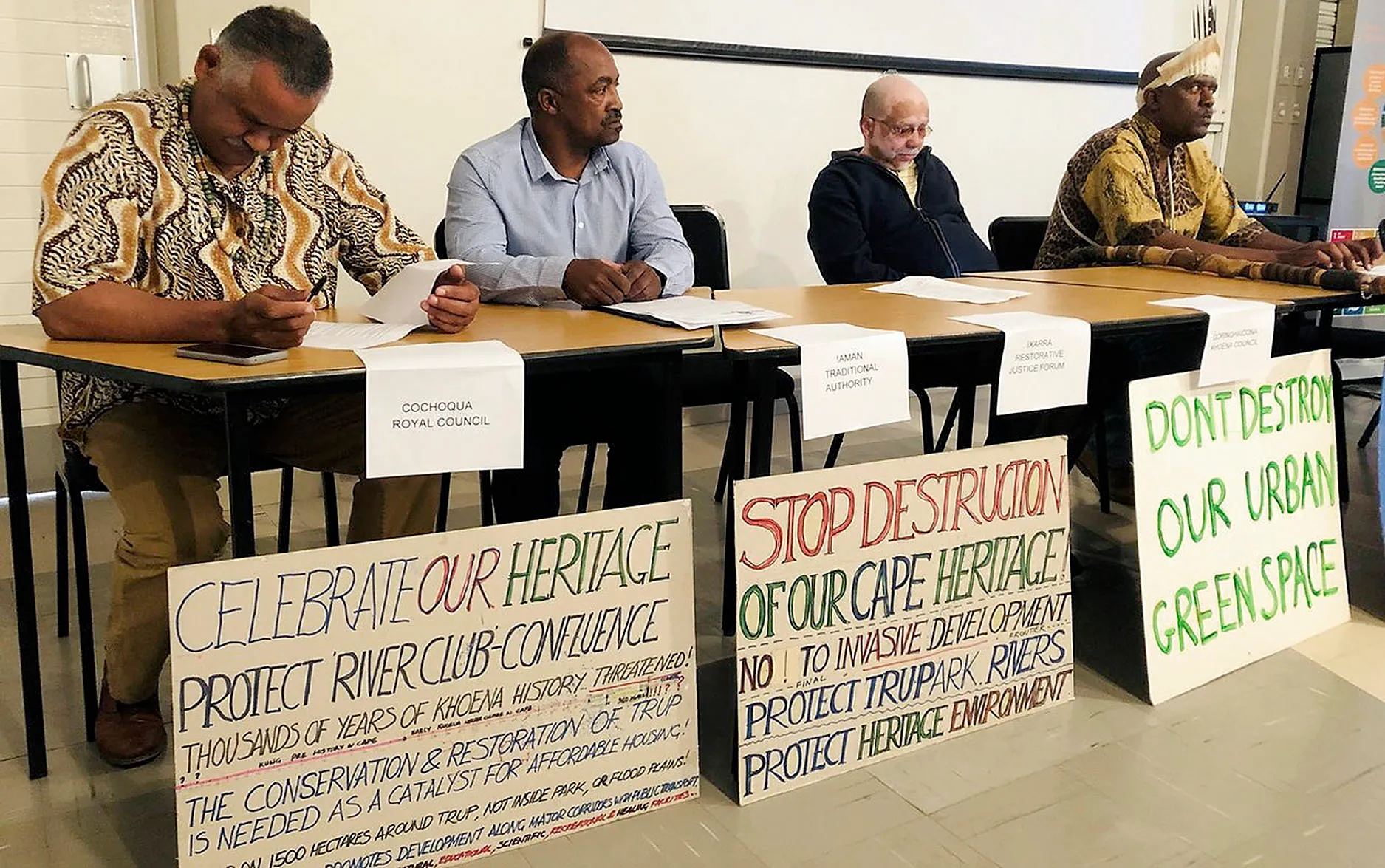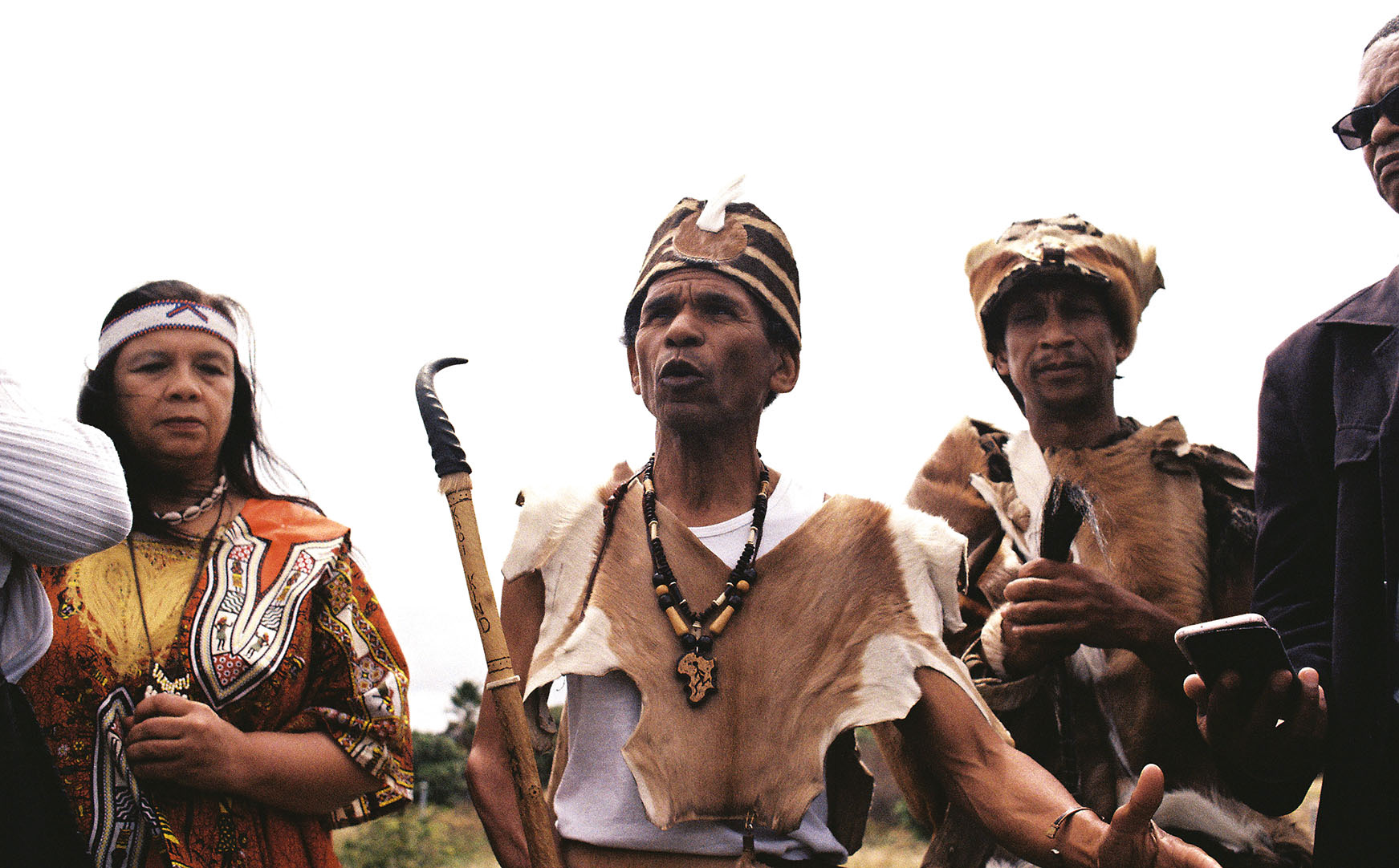Liesbeek Leisure Properties Trust claims “the majority of the Cape’s Khoi and San leaders and representatives” are in support of its R4.5-billion project to infill the land at the Liesbeek River and build luxury apartments, shopping centres and offices of up to 10 storeys, where tech monopoly Amazon will be the anchor tenant.
In fact, it is opposed more than substantially by a vast range of Khoi and San groups in the Western Cape, nationally and in southern Africa. The list includes the Goringhaicona, Kai Korana Transfrontier Land and Heritage, the Cochoqua Traditional Authority, the Khoi and San Kingdom Council of Southern Africa, the !Aman Traditional Council, the !KhoraIIgauIIaes Council, the IKhowese Nama Traditional Council, the National House of iXam San, Komani, Khwe Bushmen, IIXegwi iXam, Guriqua, Hawequa, !Xau-Sakwa, Sonqua, Karoo iXam, Kalahari iXam, !Xun, Ubiqua, the House of Klaas and the House of Dawid Stuurman.

From left, Chief Noel of the Cochoqua, Paramount Chief Fredericks of the !Aman and Nama, Paramount Chief Aran of the Garinghaicona XhoiXhoi Traditional Council and Melvin Christian Arendse of the Qoranha Transfrontier at a gathering of five First Nations groups and more than 30 civic organisations and environmental groups in the growing fight against the proposed River Club development in Cape Town. (Photo: supplied)

Khoi leaders during a heritage tribunal site visit of the River Club. (Photo: Alessandro Iovino)
The notion of “consent” peddled by the developer is clearly being misrepresented, if not outright violated.
They’re joined by revivalist umbrella organisations such as the First Indigenous Nation of Southern Africa, the Democratic Federation of Indigenous People SA, the A|Xarra Restorative Justice Forum and the Western Cape Khoisan Legislative Council. In addition, more than 56,000 people have signed a petition opposing the project and more than 60 organisations support the bestowal of heritage status on the site.
Now the Goringhaicona Khoi Khoin Indigenous Traditional Council and Observatory Civic Association have applied to the courts for an urgent interdict to halt construction so the sacred floodplain can be protected as a heritage precinct.
Old colonisers and new
The site currently being torn up by Liesbeek Leisure Properties Trust bulldozers was, in 1510, where the Gorinhaiqua defeated the forces of Portuguese Viceroy Francisco D’Almeida. In the Dutch colonial era that followed, indigenous people were driven from their traditional grazing and watering place. The confluence of the Liesbeek and Black rivers, in the traditions of the original inhabitants and their descendants, has special spiritual significance.
It’s a bitter irony that the intended anchor tenant of The River Club project is retail monopolist Amazon, which has chosen the site of the first colonial displacements in the region for its new South African headquarters. Its brand of “disruption” has already hollowed out local retail and small-scale production around the world and moved billions of dollars out of national tax environments, making it the DutchEastIndia.com of our era.
All the colours
Not to present it as too monochrome an endeavour, the trust has given its project a green sheen, too: “The project will also restore the degraded site into a beautiful and biodiverse space.” But the city’s own heritage and environmental management department concluded that the development doesn’t meet the municipality’s policies on the environment (nor does it meet the standards of the competent authority for heritage in the Western Cape, Heritage Western Cape).
So much of the land will be infilled that it will leave only 13% in a semi-natural state, and prevent several sensitive species from traversing the terrain. Oh, and also, according to urban planner Jens Horber, “to approve such a large development in a vital floodplain is a risk to city infrastructure and finances, surrounding properties, and to physical safety”.
So there’s that.
Water protectors
It’s often up to marginalised indigenous groups to defend the land against powerful, moneyed interests, and the protection of heritage and the defence against environmental destruction are frequently bound together.
In Honduras, the Lenca people fought against the builders of the Agua Zarca hydrodam, which, had it been built, would have cut communities off from the supply of water, violating their right to sustainably manage and live off their land. The campaign has been successful so far, but it cost the life of activist Berta Cáceres, whose death was ordered by the head of the dam company.
In the US, Standing Rock Sioux activists and allies call themselves the “water protectors”. Their protest centres on the Dakota Access Pipeline, which is planned to span 277km and carry 470,000 barrels of crude oil daily over land sacred to Sioux communities. Should the project proceed, the pipeline risks contaminating their water supply from the Missouri River.
It’s no coincidence that water is often at the centre of these conflicts. For indigenous communities, rivers are a source of sustenance and of spiritual importance. That Khoi and San groups can object to The River Club project “only” on environmental and heritage grounds, and not the loss of access to water for farming, is a result of colonialism. The ancestors of those who oppose the project were driven off the land centuries ago; today they’re being driven off by new, powerful global corporations, with the support of local government.
This city works for you — if you’re a developer
At nearly every turn the decisions by Cape Town’s city management seem driven entirely by property developers. How else to explain the shameful failure to build social housing within the metro centre, while selling off parcels of city-owned land to private developers at bargain prices? Or the intended sale of parts of the Philippi Horticultural Area, which supplies 80% of Cape Town’s vegetables and safeguards the Cape Flats Aquifer?
The city seems to be ignoring its own policies and pushing through developments that are anti-democratic, short-sighted and cause serious harm to our unique environment and heritage. And no amount of brownwashing or greenwashing can disguise it. DM/MC
















 Become an Insider
Become an Insider
Until this development came up I did not know about the Khoisan heritage in the area. And I doubt any of the patrons and golfers at the Riverclub over the decades knew about it either.
The proposal to include a heritage centre is brilliant and would undoubtedly see massive tourist interest and exponential exposure to Khoisan heritage.
There’s one other phenomenal cultural centre up the West Coast. But it doesn’t seem to get much interest.
The San heritage centre on the West Coast is !Khwa Ttu, and is the opposite of Amazon’s proposed Heritage centre at the contested confluence of the Liesbeeck and Black Rivers. Khwa Ttu was established on by returning land used to farm wheat to its original vegetation and repopulating it with indigenous animals. It trains young people of San descent in tourism, hospitality and conservation, and teaches the almost-lost languages of the San people. It has links to a global movement for the rights of First Peoples. Amazon promotes a rootless culture of consumerism, and any heritage centre it might establish would very likely be flimsy pretence and voyeurism, aimed at promoting its own sales and image.
The argument that Amazon’s development of the site would benefit Khoisan heritage is deluded or dishonest, or both!
Just look at the quality of zeekoei vlei,Ronde vlei,and most of the rivers in the cape peninsula and surrounds,and you will see ,coct and developers are in a love affair with keeping a green belt around cape town ala Cecil Rhodes style.Keep the elite inside and the rest of humanity outside.Stuff ecological and cultural ,historical factors, etc.Show me the money ,jerry maguire style is their attitude,developers feel the shame, develop ,make bucks, move on, #@×& the rest.Ja well stuff you,you ain’t gonna win this fight.
I have a few questions for the author:
1) Why didn’t the locals have a problem when a golf course and conference center were built on the land?
2) What do the events of 500 years ago have to do with what we do with the land today? I think the majority of people who are unemployed would welcome a development that could offers hundreds, if not thousands, of people gainful employment.
3) I am all for protecting the environment, but will the alterations to the river’s structure actually impact these people’s “source of sustenance and of spiritual importance”?
I’ve looked into this one quite a bit, I really have no horse in this race. It appears the main reason why this is getting significant opposition is that the new tenant is one of the wealthiest companies in the world with incredibly deep pockets. I have been on the site a few times when it was still a mashie golf course, there was zero attempt at any sort of heritage evidence or recognition. This is gold digging at its ugliest level, and using indigenous people as a pawn. It’s also far too late in the day here, the time to stop has passed. It reminds me of the time when Saul Goodman went after Mesa Verde bank over a call centre to be built in Tucumcari.